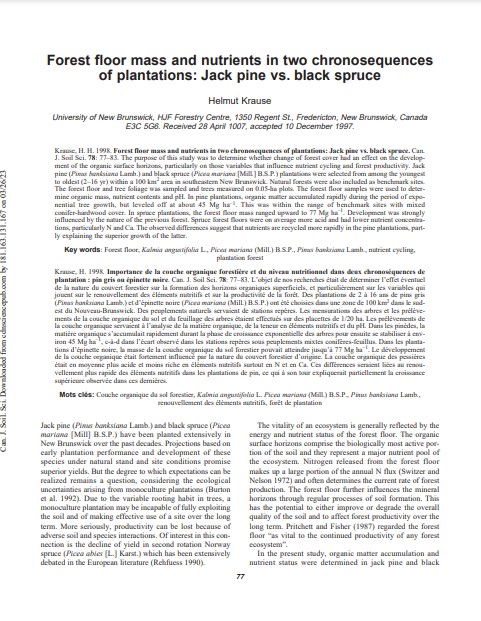Forest floor mass and nutrients in two chronosequences of plantations: Jack pine vs. black spruce
Bosque Modelo:
Fundy
Temática:
Gestión forestal
Tipo de documento:
Artículo científico
Resumen
Krause, H. H. 1998. Forest floor mass and nutrients in two chronosequences of plantations: Jack pine vs. black spruce. Can. J. Soil Sci. 78: 77–83. The purpose of this study was to determine whether change of forest cover had an effect on the development of the organic surface horizons, particularly on those variables that influence nutrient cycling and forest productivity. Jack pine (Pinus banksiana Lamb.) and black spruce (Picea mariana [Mill.] B.S.P.) plantations were selected from among the youngest to oldest (2–16 yr) within a 100 km2 area in southeastern New Brunswick. Natural forests were also included as benchmark sites. The forest floor and tree foliage was sampled and trees measured on 0.05-ha plots. The forest floor samples were used to determine organic mass, nutrient contents and pH. In pine plantations, organic matter accumulated rapidly during the period of exponential tree growth, but leveled off at about 45 Mg ha–1. This was within the range of benchmark sites with mixed conifer-hardwood cover. In spruce plantations, the forest floor mass ranged upward to 77 Mg ha–1. Development was strongly influenced by the nature of the previous forest. Spruce forest floors were on average more acid and had lower nutrient concentrations, particularly N and Ca. The observed differences suggest that nutrients are recycled more rapidly in the pine plantations, partly explaining the superior growth of the latter.
Información Bibliográfica
Autor:
Krause, H.
Revista:
Canadian Journal of Soil Science
Año:
1998
N°:
-
País :
Canadá
Páginas:
77 - 83
Volumen:
78
Idioma:
Ingles
Palabras claves
Forest floor, Kalmia angustifolia L., Picea mariana (Mill.) B.S.P., Pinus banksiana Lamb., nutrient cycling, plantation forest





